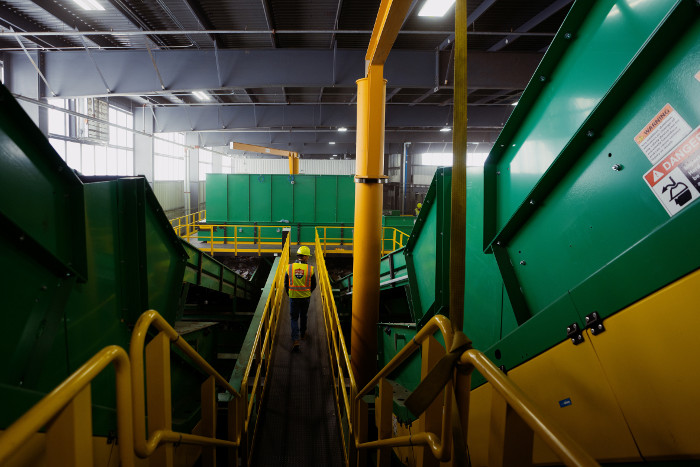
Unlocking Value
MURPHY ROAD RECYCLING in Connecticut has helped position the New England region as a nationwide recycling leader with the state’s largest recycling infrastructure investment to date—the All American MRF.
By Marissa McNees
According to a study released late last year by the New York office of U.K.- based research company Eunomia and Westminster, Colorado-based Ball Corp., Massachusetts ranks third in the U.S. for recycling with a rate of 55 per-cent and Connecticut is fifth at 52 percent—well above the 32 percent national average the U.S. Environmental Protection Agency reports.
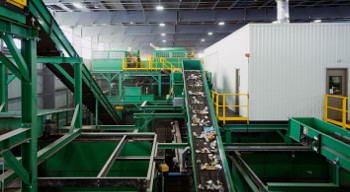 While New England has emerged as a recycling leader, material recovery facilities (MRFs) there have started to become antiquated, accord¬ing to Ryan Cournoyer, regional sales manager at Norwalk, Connecticut-based Van Dyk Recycling Solutions, who says single-stream MRFs in the region were some of the first installations nationwide.
While New England has emerged as a recycling leader, material recovery facilities (MRFs) there have started to become antiquated, accord¬ing to Ryan Cournoyer, regional sales manager at Norwalk, Connecticut-based Van Dyk Recycling Solutions, who says single-stream MRFs in the region were some of the first installations nationwide.
“With technology developing so rapidly for sorting of residential curbside collected single-stream material, plants that were designed and built in the early 2000s struggle to meet the de-mands of the end markets,” he says.
Murphy Road Recycling, based in Enfield, Connecticut, has been at the forefront of recy¬cling in New England for decades. The company is part of a family-owned and operated team of subsidiaries providing recycling and waste man¬agement services to more than 100 communities in Connecticut and western Massachusetts.
But, being leaders in the industry means changing with the times.
The company’s Berlin, Connecticut, single-stream MRF was “absolutely cutting edge” when it was built in 2005, says Frank M. Antonacci, chief operating officer at Murphy Road Recycling, but was showing its age as the 2020s approached.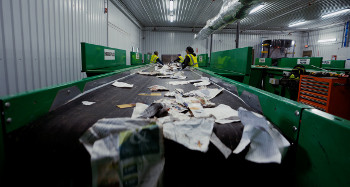
“The stream had changed dramatically,” he says. “The iPhone wasn’t even out when our first plant was built. The world has changed over the last 15, 20 years; where we live, how we live and consume is a lot different.
“Our equipment was getting tired. Volumes increased, but the composition of the stream was different and so were the requirements of the end markets. So, it was time to reinvest.”
In March 2021, Murphy Road Recycling said it would invest $30 million in what is now the All American MRF on the same site as its old MRF in Berlin. In the two years since the announce-ment, Antonacci says the results have surpassed his expectations—with more room to grow.
A COORDINATED EFFORT
Murphy Road Recycling partnered with its neighbor Van Dyk, headquartered about an hour drive from the MRF, to supply the processing sys¬tem, which includes sizing equipment, optical sorters, artificial intelligence and robotics, with the intention to design a facility that could meet the needs of an ever-changing recycling stream.
“The region needed this investment in tech¬nology for many years as market demands have been exceeding the capacity in New England,” Cournoyer says.
The initial stages of the project began in 2018 when Antonacci and his family started touring facilities in the U.S. and abroad to determine what Murphy Road wanted for its new MRF.
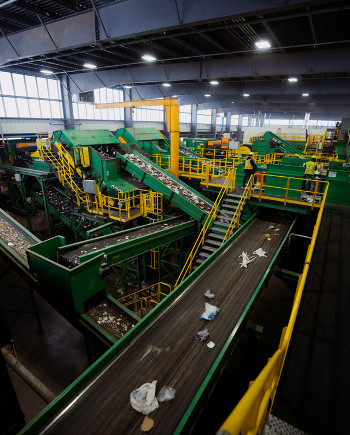 He says his father, uncle, brothers and cous¬ins—all of whom are involved with the compa¬ny—toured different facilities and gave input on what they liked and didn’t like, and everyone was on board with the final contract negotiations and signing the deal.
He says his father, uncle, brothers and cous¬ins—all of whom are involved with the compa¬ny—toured different facilities and gave input on what they liked and didn’t like, and everyone was on board with the final contract negotiations and signing the deal.
The group also did its due diligence when it came to suppliers, and the partnership with Van Dyk seemed like a natural fit because of the long-standing relationship between the two companies as Van Dyk supplied two commercial systems for Murphy Road over the years.
“When it came time for them to consider a new single-stream facility, they had a large team researching the latest technology in the field,” Van Dyk President Pieter van Dijk says. “They wanted equipment that could make the absolute most out of single-stream material in terms of recovery and purity.”
The contract for the All American MRF was signed Dec. 11, 2020, during the height of the coronavirus pandemic. “If you think about all that was going on—it was the first year of COVID; business in general was in a very weird time,” Antonacci says. “But we had confidence in what we were doing and that … this would be an important piece of infrastructure needed in the whole New England region.
“Our goal was to build a facility with more capacity than our immediate needs and be able to handle additional recyclable commodities, therefore diverting more material from the waste streams.”
The most challenging part of the project was the fact that Murphy Road Recycling maintained full operations at its soon-to-be-closed facility adjacent to the new building while constructing the All American MRF.
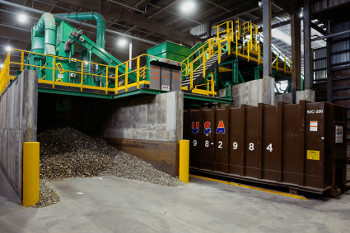 About six months prior to breaking ground on the new building, existing infrastructure was moved out of the construction zone, which Joe Farese, operations manager at the All American MRF, says took great effort and communication to ensure timeliness and safety.
About six months prior to breaking ground on the new building, existing infrastructure was moved out of the construction zone, which Joe Farese, operations manager at the All American MRF, says took great effort and communication to ensure timeliness and safety.
“The focus was that we couldn’t really let our guard down,” he says. “We still had to maintain a high level of safety and maintenance on the old system, even though we knew it was coming to the end of its useful life.”
On top of building a new MRF in conjunction with maintaining operations at the existing plant, some of the equipment, including a screen, was taken from the old system and installed into the new one.
After removing the screen that was to be integrated into the new system, what was left of the old system was dismantled and the metal recycled. With the addition of the new MRF, the buildings on-site went from about 50,000 square feet to 110,000 square feet. The MRF’s improved glass sorting operations are housed in part of the old building, while the rest was converted into warehouse space.
“Although it was difficult,” Farese says, “they knew at the end of it … they were going to end up with a brand new, state-of-the-art facility, which really had the whole team excited.” By the time construction was completed, Antonacci says the investment was closer to $40 million than the previously announced $30 million. The system was up and running in September 2022 and, by December, the plant was fully operational.
“We’re very much boots-on-the-ground type of leadership here, and we built an industry-leading team around our recycling operations and infrastructure,” Antonacci says. “We leveraged our collective experience and expertise with the added nuances of knowing the area to make sure this project went off smoothly. We accomplished something special for our customers in Connecticut and Massachusetts. It was a well-choreographed dance everybody pulled off.”
INSIDE THE MRF
The old facility processed up to 350 tons per day, while the new All American MRF processes up to 60 tons per hour, more than 1,000 tons per day and about 200,000 tons per year, which Antonacci says enabled his company to pour much more into the technology side.
Cournoyer says the MRF prepares material for downstream processing using nonwrapping screening technology and 11 optical sorters that clean and positively sort fiber to make four separate grades “to accommodate market fluctuations and appease multiple end-market outlets.”
The MRF also employs an additional laser sensor, known as Deep Laiser, that works in concert with the other sensors and detects material on the conveyor belt that the near-infrared technology is incapable of identifying, such as black plastics and film, removing them from the fiber stream. The container line also includes fully automated quality control using optical sorting technology.
“The All American MRF’s efficient design and creative use of optical sorters operates at 50 tons per hour with 12 manual sorters, far exceeding performances of the past,” Cournoyer says, calling the facility one of the most automated MRFs in North America.
Murphy Road Recycling also invested in improving glass sorting, employing a glass benefication system to produce a cleaner product. Glass previously was shipped to Pennsylvania, New Jersey, Ohio and other neighboring states because the material was not clean enough to be accepted locally. Now, all the glass recovered by the MRF remains in Connecticut, either as an ingredient for concrete or for use in insulation or containers.
“We’re able to support local businesses in Connecticut … which is really exciting,” says Jonathan Murray, director of operations at Murphy Road Recycling. “It’s always really nice to keep it local.
“There are better screens, better opticals, elliptical sorting—all the new equipment has allowed us to make a better product and do it more efficiently. … We were sorting glass [at the old MRF], but the new system makes very clean glass.”
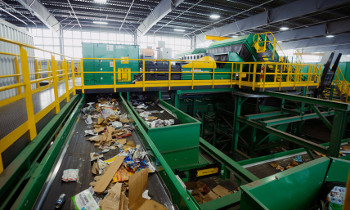 The team at Murphy Road Recycling agrees the laser technology the MRF’s optical sorters use has exceeded expectations as it pertains to polypropylene (PP) sorting—specifically those black plastics that previously could not be recovered for recycling. There was a certain skepticism over how well the technology would work, but now the company can tell the community to recycle those items and recover valuable material.
The team at Murphy Road Recycling agrees the laser technology the MRF’s optical sorters use has exceeded expectations as it pertains to polypropylene (PP) sorting—specifically those black plastics that previously could not be recovered for recycling. There was a certain skepticism over how well the technology would work, but now the company can tell the community to recycle those items and recover valuable material.
“It’s working fantastic, especially with the pandemic and all the black takeout containers. It’s really cool to see all those come through,” Antonacci says. “Up here in New England, Dunkin’ Donuts is pretty popular—all the Dunkin’ Donuts and Starbucks cold cups, we’re getting all those. It’s cool to see these materials that, before we built this plant, I would have told you to put in the trash that [now] we can recover. … It’s a really important opportunity for the whole region.”
Farese says recycling systems typically run at about 90 percent efficiency, but with improved sorting technology, the All American MRF has built on an already high efficiency rate by an end-of-the-line recovery unit, recirculating recyclables while nonrecyclables end up in residue.
It also was important to build an adaptable MRF that can be adjusted as the recycling stream continues to change.
Murray says the optical sorters easily are reprogrammed to sort different materials if the team notices changes in composition. “We can increase air flow in certain areas if we need to do more sorting of paper off the elliptical, or we can also adjust the opticals to look for different materials if there are more brown [grades] or less browns,” he adds. “We’re able to redirect the programming to manage that, and Van Dyk and Bollegraaf have made a very adaptable system.”
The facility was built to allow space for additional equipment down the line, and Antonacci says some design additions already are in the works this year.
“The material stream is a living, breathing, changing animal, so this is going to be a living, breathing, changing beast to consume it,” he says. “This project, to do it right, will never be done.”
CREATING THE IDEAL WORK ENVIRONMENT
Murphy Road Recycling has addressed labor issues by investing in making the All American MRF safe and comfortable to work in and, Antonacci says, paying employees well above minimum wage. He emphasized safety during the design and construction process and says it’s something his entire family is passionate about.
Automation was key to safety. Antonacci says no employees are on the container lines and much of the work is done on iPads. “We automated absolutely everything,” he says. “Once the material goes into the system [and] gets separated, it never gets dropped back on the floor. It all goes to bunkers that are fully automated. We have visibility into how full they are, and we select either one of our two balers —all those things are very important.”
A second shift was added, bringing the total number of employees to 50 — 25 per shift.
Murray echoes Antonacci’s sentiment about the work environment. “We did a lot of things to make sure employees didn’t have to say, ‘Boy, I don’t want to go to work there,’” he says.
The quality control rooms are all climate-controlled, the system was designed to minimize the number of people working beneath it, and walkways and platforms were thoughtfully built to avoid employees dealing with forklift traffic or fallen objects. “They were thinking of the employees when they were designing the system, not just the most efficient way to process recyclables,” Farese says.
Addressing safety concerns around the risks of lithium-ion batteries in the recycling stream also was critical to Antonacci, who calls the issue the biggest threat to the recycling and waste industry in the U.S.
The company overengineered its sprinkler systems and has redundancy with its fire prevention equipment provided by West Bloomfield, Michigan-based Fire Rover. The MRF features thermal imaging cameras, and Antonacci says an additional thermal imaging camera will be installed on its infeed line. A deluge pipe system also was installed in both the MRF’s feed hoppers that, when activated, can dump thousands of gallons of water per minute. “We put more fire-fighting equipment in here than we ever have,” Antonacci says.
NEXT STEPS
With the construction of the All American MRF, the hope is that confidence in single stream recycling nationwide is boosted by this investment, not just in New England.
“I think [recently] recycling has gotten a bad name—much of which was not justified to begin with,” Antonacci says. “I’ve given many tours at this facility, and there’s not one person that’s left unimpressed on both the quality and the quantity of materials we’re able to recover.”
Along with tours, the company will launch an educational campaign to promote pride in the region’s recycling operations and continue instilling confidence in the U.S. recycling industry.
“There are some misguided narratives out there because people lack the understanding of what really happens,” Antonacci says. “We’re trying to take down that barrier of what really happens—bring people to the facility and show people that single-stream recycling is extremely successful and, if done right, can really unlock value to all of us.”
As seen in Recycling Today.
